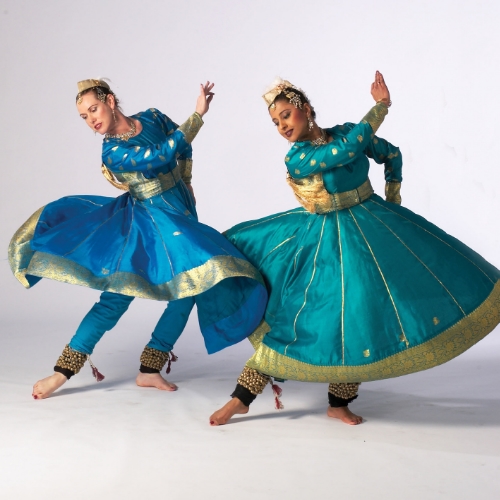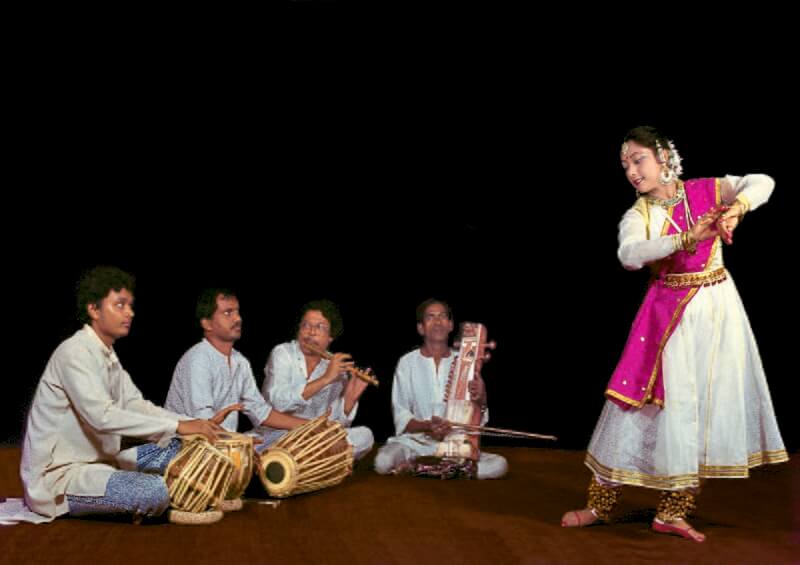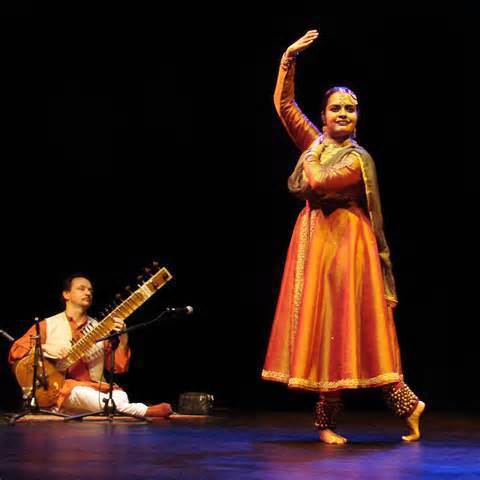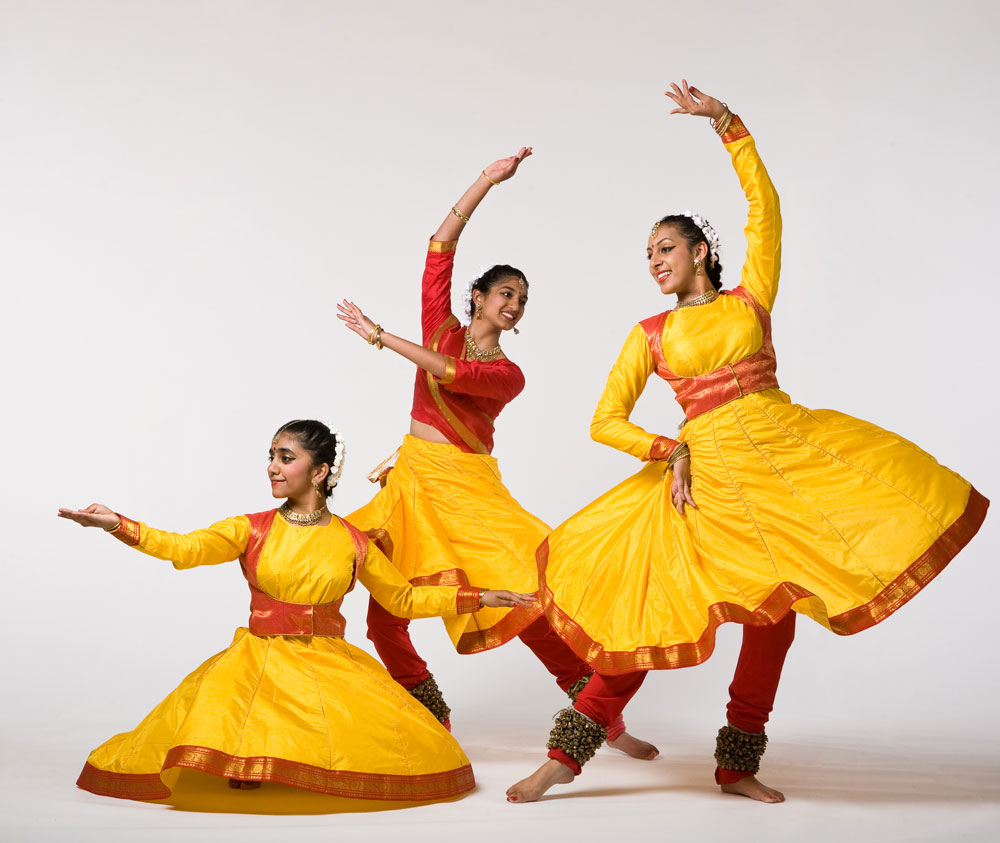- Home
- Culture of India
- Indian Dances
- Kathak
Kathak- classical dance form of India
Kathak is one of the main classical dance drama forms of India. The other classical dances being Bharatanatyam, Kuchipudi, Odissi, Kathakali, Mohiniyattam, Sattriyya and Manipuri. The style of Indian classical dance form is very bright, vibrant and colorful. It is one of the ancient traditional dance forms believed to have originated from the northern part of India.
The word Kathak is derived from the Sanskrit word “Khatha” which means story and Kathakars mean storytellers. These Kathakars moved from one place to another by reciting stories through dance, song and music. The kathakars usually illustrated the story of Lord Krishna through hand and foot movements along with facial expressions. The Kathak dance form evolved during the bhakti movement.
During the Mughal rule in India, the emperors encouraged the performers to perform Kathak in their royal courts. Kathak is practised by three different schools or gharanas namely Jaipur, Banaras and Lucknow. The main difference between these schools is acting and footwork. The Lucknow and Banaras school gives importance on acting and Jaipur gives importance on footwork. Among all the three gharanas Banaras is the oldest gharana. The dance begins with a prayer to God, to the Guru and to all the musicians on the stage.
History and Evolution of kathak
Kathak is a very old dance form, according to Mary Snodgrass this form evolved as early as 400 BC. Like other dance forms even kathak has its roots from the ancient text Natya Shastra written by Bharata Muni. Natya Shastra has around 6000 verses and 36 chapters. It is a Sanskrit text based on performing arts accredited to Bharata Muni. It is presumed that the full version was first completed between 200 BCE to 200 CE but also varies from 500 BCE to 500 CE.
According to Russian scholar Natalia Lidova, Natya Shastra gives an in-depth theory on Indian classical dances which includes Tandava dance from Lord Shiva, the theory of rasa, bhava, facial expressions, foot movements, gestures which all are included in Kathak. Even the 2nd century panels in Bharhut ( a small village in Satna district of Madhya Pradesh) show dancers in vertical pose with arm position which resembles Kathak steps. This reflected the ‘pataka hasta’ Mudra. Several text-based analysis indicate that Kathak is an ancient Indian classical dance form which is believed to have originated in Banara and then later spread to Jaipur, Lucknow and other parts of India.

Bhakti Movement
It is believed that Kathak originated in Banaras and later spread its wings to other parts of India. The Lucknow gharana was founded by Ishwari Prasad who was a devotee of Bhakti Movement. He belonged to Handia village in Uttar Pradesh.
It is believed and said that lord Krishna appeared in his dreams and asked him to develop a “dance as a form of worship.” Following his dreams, Ishwari taught the dance form to his sons Aduji, Khadguji and Tularamji. They in turn continued the tradition by teaching to their descendants which continued for six generations. This legacy was acknowledged as the Lucknow gharana of Kathak both by Hindus and Muslims. During the Bhakti Movement the dance form primarily focused on the stories of Lord Krishna and his eternal love to Radha and gopis as found in the text of Bhagavata Purana.
Mughal Era
This ancient classical dance form got momentum with the arrival of Mughals to India. However, the transition from the temple to the palace court made a lot of changes in the dance form and the costume. The dance form became more of an entertainment for the rulers of the Mughals. Mughals gave more importance to nritya and bhavag it means it became more sensuous during the Mughal period. It was accepted as more of a rich class entertainment provided by the low-income class people.
Eventually even the central Asian and Persian themes were part of its repertoire. The dance form made many changes even in the costume. Sari was replaced by another costume that bared midriff with a transparent veil which was commonly worn by medieval Harem dancers. The dance was already famous as a court entertainment and a blend of ancient Indian classical dance form and Persian dance form, and the dancers were called ‘nautch girls.’
Colonial Era
During British rule in India, Kathak and other classical dance forms were discouraged and saw a decline. The Anglican missionaries criticized Hinduism and Reverend James Long suggested that Kathak dancers should perform for the tales associated with European legends and Christian tales and forget the ancient Hindu tales. The Christian Missionaries started an anti-dance movement in 1892. The postures, gestures and the facial expressions in the dance was severely caricatured in the book ‘The Wrongs of Indian Womanhood; written by Marcus B Fuller.
The natuch girls highly faced humiliation by the newspapers and the officials of colonial rule. They were under pressure to stop supporting the Kathak dancers. The social stigma which got associated with nautch girls further added a disgraceful attitude from the officials and the Christian missionaries who considered them and the Devadasis as harlots and slavery to idols and priests. They were suppressed economically as well.
The Madras Presidency banned the custom of performing dance in Hindu temples in 1910. There was a mass agitation by the Indian community on the ban. The Hindu families did not stop the tradition but they secretly did private tutoring to keep the art alive. They even started training boys to keep the tradition alive.
Revival
Lot of efforts were made to revive the art and keep up the Indian tradition. The Indian freedom movement gave an effort to revive the rich Indian culture and tradition. The revival of Kathak dance developed both in Hindu and Muslim gharanas especially in the kathak Mishra community. The Kathak department was formed in 1956 at Indra Kala Sangeet University which included the first Kathak syllabus for degree programs. Kalkaprasad Maharaj played an important role in developing Kathak in the early 20th century.
Repertoire

Repertoire:
However, the present-day form of Kathak includes invocation, a pure dance recital and another expressive recital form in all three gharanas. In the invocation the dancers come on the stage and offer respect to his guru and to the musicians on the stage. If the performance is from Hindu tradition, then the dancer fold hands and with facial expressions seek blessings of Hindu gods and goddess but if it is Muslim performance then they replace the devotional expressions with salami.
The dance includes both the form Nritta and Nritya. Nritta is the pure form of dance and Nritya is the expressive form of dance. Nritta begins with slow and steady movement of eyebrows, hands and neck. The speed gradually increases before the completion of one bol. As soon as one section is completed the dancers usually take a sharp turn of the head. In Nritta the foot movements are called tatkars.
However in Nritya emphasis is given to communicate the feelings through dance form. Its main aim is to engage the viewers mentally and emotionally. The most common instruments used in kathak are tabla, sarangi and manjira.
The dance can be a solo dance or a group dance. To engage the audience one or more artists may come to them and interact with the audience. Also the speed and the energy of the dance increases to keep the tempo of the audience.
Kathak involves a lot of upper body movement and hand movements. The foot work is very important. The dancers wear ghungroo in this dance form also. Eyes show the expressions and act as a medium of communication of what is being recited in the story.
Costume worn by the dancers
Since the Kathak dance is famous among both Hindus and Muslim communities, the costume is worn according to tradition. There are two kinds of costumes for females. Hindu dancers. The first is both saree and blouse to cover the upper part of the body and the second is a long full length embroidered skirt with a contrasting choli and transparent scarf which drapes over the skirt and choli.
The skirt has a lot of flares with different colour contrast. A scarf is tied from the upper body till waist. Lot of jewellery is worn along with a lot of makeup. Jewellery is worn on the neck, wrist, ear and on the face. The male dancers usually wear a dhoti and tight chudi pyjamas with a scarf that covers their upper body. Ghungroo made of cloth strap is tied to both their ankles by both male and female performers to produce melodious sound during the spectacular foot work.
The male Hindu usually wears a silk dothi around the waist with a scarf tied over it. The upper body is usually left bare with only hindu thread. Sometimes it is covered with a sleeveless jacket.
The Muslim female dancers wear a long skirt with tight pyjamas and a long coat covering the hands and the upper part of the body. The head is covered with a scarf, and they also wear light jewelry.
Instruments and music

The Kathak dancers use many instruments. Some of the common instruments used are table, sarangi, manjira and harmonium. The ancient music Dhrupad was reintroduced into Kathak by Mahamahopadhyay Dr Pandit Puru Dadheech. He is India's first Kathak dancer who got Dhrupad on the Kathak stage.
Famous Dancers
Some of the famous dancers of this form include Shambhu Maharaj and his brothers Lachhu Maharaj and Acchan Maharaj all belong to Lucknow school. Some other artists include Kumudini Lakia, Roshan Kumari and many more.
Update on coronavirus in India
Affiliate Disclosure:
If you make any purchase via a link on this site, I may receive a small commission with no added cost to you.



